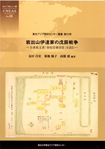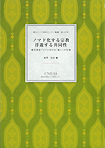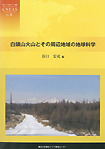Research results of CNEAS joint research projects and individual projects, irregular publication.



- Tohoku Ajia ni okeru koeki kyoten no hikaku kenkyu [Comparative Studies of Trade Centers in Northeast Asia], ed. Yamada Katsuyoshi. 2001.
- Rezanofu hen, “Ro-Nichi jiten/Ro-Nichi kaiwa cho” [Russian-Japanese Dictionary and Phrase Book Written and Compiled by Nikolaj Rezanov], trans. and ed. Tanaka Tsugune. 2001.
- Kan-Chuka no girei to geino: Chosen o jiku ni [Ritual and Performing Arts in the Pan-Chinese World: Focus on Korea], ed. Narisawa Masaru. 2001.
- “Gen-cho hishi” Mongoru go zentango/gobi sakuin [Word- and Suffix-Index to The Secret History of the Mongol based on the Romanized Transcription of L. Ligeti], eds. Kuribayashi Hitoshi and Choijinjab. 2001.
- Mantle Evolution beneath the Baikai Rift, Konstantin Litasov and Hiromitsu Taniguchi. 2002. (In English)
- Mongoru kenkyu ronshu [Mongolian Studies at CNEAS], ed. Oka Hiroki. 2002.
- Higashi Ajia sankoku ni okeru jidosha hoyu-riyo no jittai to shakai ishiki no chosa kenkyu: Keizai seicho jidosha riyo to kankyo no chowa o mezashite [An Empirical Study on Car Ownership-Usage and Social Awareness in Three East Asian Countries Aiming at Sustainable Development of Car Use], ed. Miyamoto Kazuaki. 2002.
- Bunka no disupurei: Tohoku Ajia sho-shakai ni okeru hakubutsukan, kanko, soshite minzoku bunka no saihen [The Display of Culture: Museums, Tourism, and the Redefinition of Ethnic Culture in Northeast Asia], ed. Segawa Masahisa. 2003.
- Tohoku Daigaku shozo Bungo-Saiki han “I-ro-ha-wake shomoku” no kenkyu [The “I-Ro-Ha Wake Shomoku” of the Bungo-Saiki Domain, Tohoku University Library], ed. Isobe Akira. 2003.
- “Hua-yi yi-yu” Mongoru-go zentango-gobi sakuin [Word- and Suffix-Index to Hua-yi yi-yu based on the Romanized Transcription of L. Ligeti], ed, Kuribayashi Hitoshi. 2003.
- Ko-tsungusu shozoku funbo no hikaku kenkyu [Comparative Studies of the Tombs of Ancient Tungus], eds. Zheng Yongzhen and Narisawa Masaru. 2003.
- Shiberia yokuryu shibosha meibo [List of Deceased Japanese Internees in the Former Soviet Union after World War II], ed. A. A. Kirichenko. 2003.
- Chuo Yurashia ni okeru minzoku bunka to rekishizo [Cultures and Historiography in Central Eurasia: Nations, Ethnicities, and Societies], eds. Kuroda Takashi, Takakura Hiroki, and Shiotani Masashi. 2003.
- Meiji-Taisho-ki ni okeru Negishi-machi Shiki-an no fukei [Shiki and Soseki: A Relationship between Great Writers in the Meiji-Taisho Eras], ed. Isobe Akira. 2003.
- Roshia shiryo ni miru 18-19-seki no Nichi-Ro kankei, dai-1 shu [Japanese-Russian Relations during the 18th-19th Centuries Based on the Russian Archives, Part 1], sup. ed. Hirakawa Arata. 2004.
- Chugoku tohokubu Hakutosan 10-seiki kyodai funka to sono rekishi koka [The Great Tenth Century Eruption of the Baitoushan Volcano, Northeast China, and Its Historic Effect], ed. Taniguchi Hiromitsu. 2003.
- Annotated Catalogue of the Collection of Mongolian Manuscripts and Xylographs MI of the Institute of Mongolian, Tibetan, and Buddhist Studies of the Siberian Branch of the Russian Academy of Sciences, comp. Nikolay Tsyrempilov; ed Tsymzhit Vanchikova. 2004. (In English)
- Explosive Volcanoes in the Philippines, Sandra. G. Catane, Hiromitsu Taniguchi, Goto Akio, et al. 2005. (In English)
- Keio Gijuku Toshokan Shozo Binsaido-kan “Shinkoku Zoho hihyo zenzo Saiyuki” no kenkyu to shiryo [Study and Documents on the Minzhaitan-published “Critiques of Hsiyu Chi (Journey to the West), Revised and Enlarged,” in the Possession of the Keio University Library], ed. Isobe Akira. 2006.
- “Gyosei Manju Mouko Kanji Sangou Setsuon Shinbunkan” Mongoru-go hairetsu taisho goi [The Manchu-Mongolian-Chinese Triglot Dictionary of 1780 Arranged by Mongolian Words], eds. Kuribayashi Hitoshi and Hurelbator. 2006.
- Magmatic Response to the Late Phanerozoic Plate Subduction Beneath East Asia, S. V. Rasskazov and Hiromitsu Taniguchi. 2006. (In English)
- NOAA deta no riyo ni yoru Tohoku Ajia no kankyo hendo kaiseki to detabesu sakusei ni kansuru gakusaiteki kenkyu [Interdisciplinary Studies of Analysis of Environmental Change in Northeast Asia Using NOAA Data, and Database Creation], eds. Yamada Katsuyoshi and Kudoh Jun-ichi, 2006.
- Keio Gijuku Toshokan shozo Binsaido-kan “Shinkoku zoho hihyo zenzo Saiyuki” no kenkyu to shiryo, ge [Research and Documents on the Keio University Library “Xin-ke Zeng-bu Pi-ping Quan-xiang Xi-you ji” published by the Min-zhai Tang (Ⅱ)], 2], ed. Isobe Akira, 2006.
- Annotated Catalogue of the Collection of Mongolian Manuscripts and Xylographs MII of the Institute of Mongolian, Tibetan and Buddhist Studies of the Siberian Branch of Russian Academy of Sciences, compiled by Nikolay Tsyrempilov, edited by Tsymzhit Vanchikova, 2006. [in English]
- Kainanto no chiho bunka ni kansuru bunkajinruigaku-teki kenkyu [A Cultural Anthropological Study of Local Culture on Hainan Island], ed. Segawa Masahisa, 2007.
- Roshia shiryo ni miru 18-19 seiki no Nichi-Ro kankei, dai-2 shu [Japanese Russian Relations during the Eighteenth-Nineteenth Centuries Based on the Russian Archives, Part 2], sup. ed. Hirakawa Arata, 2007.
- Mongoru no kankyo to hen'yo suru shakai [Mongolia's Environment and Changing Society], ed. Oka Hiroki, 2007.
(Note: Name order as in published work.) - Monitoring of Vegetation Fires in Northeast Asia, L. Kondrashov and J. Kudoh, 2008.
- A Study and Material of “Xin-ke Jing-ben Quan-xiang Yan-yi San-guo Zhi zhuan” published by the Fei Shou-zhai, Akira Isobe, 2008.
- Manchu-Mongolian-Chinese Triglot Dictionary of 1780 Arranged by Manchu Words, Hitoshi Kuribayashi and Hurelbator, 2008.
- Japanese-Russian Relations in the 18th and 19th Centuries: A Documentary Record. Vol.3, Arata Hirakawa(Supervised), Kyosuke Terayama, Tadashi Hatakeyama, Utako Onodera(Edited and Translated), 2008.
- Soviet policy toward Mongolia in the 1930s' : from the Manchurian incident to the Nomonhan, Kyosuke Terayama, 2009.
- Word-index to the Secret history of the Mongols with Chinese transcriptions and glosses, Hitoshi Kuribayashi, 2009.
- The possibility of self-referential ethnography, LEE In ja and Miwa Kanetani, 2009.
- Tohoku Ajia chiiki NOAA gazou data base kouchiku to bunkei bunya heno riyou kenkyu houkokusho, Jun-ichi Kudoh, 2009.
- Japanese-Russian Relations in the 18th and 19th Centuries: A Documentary Record. Vol.4, Arata Hirakawa(Supervised), Kyosuke Terayama, Tadashi Hatakeyama, Utako Onodera(Edited and Translated), 2009.
- Mongolian-Chinese-Manchu Triglot Dictionary of 1891, Hitoshi Kuribayashi, Mengwen Zonghui,2010
- At the Nexus of the Society of Sendai Domain under Disasters in the 18th to 19th Centuries : The Analysis and Material of Bessho Man`emon’s Personal Records, Daisuke Sato, 2010
- Supervised by Hirakawa Arata, eds. Terayama Kyosuke, Hatakeyama Tadashi, Onodera Utako, Japanese-Russian Relations in the 18th and 19th Centuries: A Documentary Record, Vol. 5, 2010.
- The Original Texts of Two Denominational Precious Volumes Published in the Early Qing, with Explanatory Remarks: Pufu zhouliu wushisan can baojuan and Yaoqin sanzang xitian qu qing jielun, Akira Isobe, 2010.
- Earth science of Baitoushan volcano and its adjacent area, Hiromitsu TANIGUCHI, 2010
- A Study on “Quan-xiang San-guo Zhi zhuan” published by the Zheng Yun-lin from Takaoka Central Library Collection (I), Akira ISOBE ed., 2011.
- Nomadizing Religion and Floating Communality: Topology of "Salvation" in Contemporary Northeast Asia, Katsuhiko Takizawa (ed.), 2011.
- A Study on “Quan-xiang San-guo Zhi zhuan” published by the Zheng Yun-lin from Takaoka Central Library Collection (II), Akira ISOBE ed. 2011.
- Re-defining history, Oka Hiroki, 2011
- Written Mongolian and Written Manchu Indices to the Dagur Vocabulary, Hitoshi Kuribayashi,2012.
- Chinese Word-Index to the Secret History of the Mongols, Hitoshi Kuribayashi, 2012.
- Written Mongolian Index to the Baoan Vocabulary, Hitoshi Kuribayashi, 2012.
- The Report on the Culture of Court Theatre during the Qing Dynasty, Akira Isobe, 2012.
- Hot Springs and Interaction in Edo period [The World of the Historical Documents of Sato Niemon in Maekawa Village of Shibata Province of Mutsu ], TAKAHASHI Yohichi, 2013.
- Written Mongolian Index to The Monguor Vocabulary, Hitoshi Kuribayashi, 2013.
- Mengwen Daogang [Arranged by Romanized Mongolian Words with Chinese and Manchu], Hitoshi Kuribayashi and Sechinbat, 2014.
- The Bosin War for the Iwadeyama Date Family[Deciphering the Historical document “Hoshukujaku Goyodome” owned by the Agatsuma Family―, TOMODA Masahiro, KIKUCHI Yuko, TAKAHASHI Sakari, 2014.
- A Descriptive Catalogue of Kaminoyama-han Meishinkan Bunko in Kaminoyama City Library, ISOBE Akira, 2014.
- A Study of Chu-xue zhi-nan(初學指南)-Colloquial Mongolian of the 18th Century-, Hitoshi Kuribayashi, Sechenbat eds., 2015.
- Illustrated Catalogue of the Chinese classical books in the Asano Collection, Hiroshima City Central Library, ISOBE Akira ed. 2015.
- Mengwen Zidian : Mongolian-Chinese Dictionary of 1928 Arranged by Romanized Mongolian Words, Hitoshi Kuribayashi ed. 2016
- Production, Distribution and Consumption in Mongolian Pastoral Society, KAZATO Mari,OZAKI Takahiro,TAKAKURA Hiroki eds. 2016.
- Monguor-Chinese Integrated Dictionary, Hitoshi Kuribayashi ed. 2016.
- Written Mongolian Incices to The Dungshang Vocabulary and The New Shera-Yögur Vocabulary, Hitoshi Kuribayashi ed. 2016.
- Integrated Dictionary of Written Oirat, Hitoshi Kuribayashi ed. 2017.
- Mongolian Bible Translations: In the Context of the History of Religious Cultural Exchange, Katsuhiko Takizawa, Yutaka Shibayama ed. 2017.
- Blanislaw Pilsudski’s Sakhalin Ethnography: The Enchiw, Nivkh and Uilta around the beginning of the 20th century, Translated, edited and annotated by Koichi Inoue, Supervised by Hiroki Takakura, 2018.
- The Immigration of the Lord of Iwadeyama-Date and his Ex-Vassals to and their Cultivation of Hokkaido: Reading the Agatsuma House Archives, TOMODA Masahiro,KIKUCHI Yuko,TAKAHASHI Sakari, 2018.
- Urbanization and Traditional Dwellings in Contemporary Mongolia: Housing management and Home Construction in Ger Area, Ulaanbaatar, Takiguchi Ryo ed. Yatsuo Hiroshi, Sakamoto Go, Sato Noriyuki, Matsumiya Yuko, G.Luvsanjamts, 2018.
- Shinto priest historical documents of the Shiogama shrine in the Edo period, Kenichiro Aratake, Yoichi Takahashi(eds), 2019.
- Mobility and Symbiosis in Northeast Asia: On the Frontier of China, Mongolia, Russia and Korea, Hiroki Oka ed., 2020.
- The fencer of the common people in Dewa: "Bugenryu Kenjutu Jitsuroku" by Gunta Takeda, Arata Hirakawa ed., 2021.
- The Real Image of Society as Seen in Regional Newspapers from the Late Modern Period: Reading the Shiroishi Jitsugyo Shimpo of Miyagi Prefecture, Kenichiro Aratake, Sayaka Abe eds., 2021.
- The Documents of Ōeda Family served as Bugyo(Chief Retainer)in Sendai Domain : Family, Chigyo-chi, and Role, Teiji Nomoto, 2022.
- Under the Ancestors’ Glory, Masahisa Segawa, 2022.
- The Documents of Gotou Family served as Syukuro(Senior Vassal)in Sendai Domain : History, Role, and Martial Arts, Teiji Nomoto, The Nangou Komonjyo Reading Group, 2023.
- Drifting Records and Drifting People in the Edo Period - Drifting Chronology and Drifting Catalog -, Hirakawa Arata , Takehara Kazuo, 2023.
- The official document of the Tohoku district farm village in 1827: The documents of Kuwana family in Sukagawa City, Kenichiro Aratake, Sakuichi Takeda eds., 2023.
- The Sato family documents of the Katakura family vassal in Shiroishi: Documents of the samurai in Zao Town, Miyagi Prefecture, Kenichiro Aratake, Shiroishi Komonjo Group eds., 2024.
- Reading the Agatsuma Family Documents 1:The Organization of the Iwadeyama Date Family, Kenichiro Aratake, Iwadeyama Komonjo Group eds., 2025.